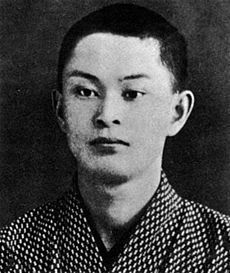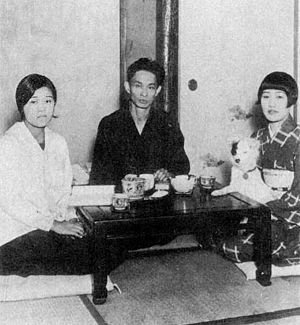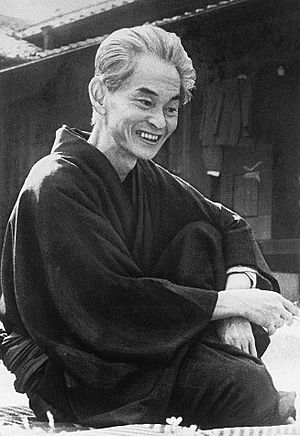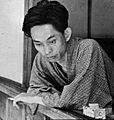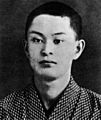Yasunari Kawabata facts for kids
Quick facts for kids
Yasunari Kawabata
|
|||||
|---|---|---|---|---|---|
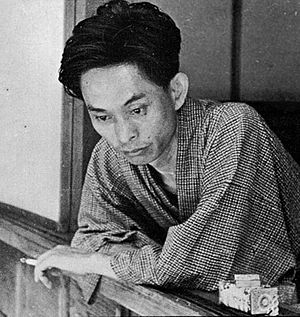
Kawabata at his home in Kamakura
|
|||||
| Born | 11 June 1899 Osaka, Japan |
||||
| Died | 16 April 1972 (aged 72) Zushi, Kanagawa, Japan |
||||
| Occupation | Writer | ||||
| Alma mater | University of Tokyo | ||||
| Period | 1924–1972 | ||||
| Genre | Novels, short stories | ||||
| Literary movement | Shinkankakuha | ||||
| Notable works | Snow Country, The Master of Go, The Dancing Girl of Izu, The Old Capital | ||||
| Notable awards | Nobel Prize in Literature 1968 |
||||
| Spouse | Hideko Kawabata | ||||
| Japanese name | |||||
| Kanji | 川端 康成 | ||||
| Hiragana | かわばた やすなり | ||||
| Katakana | カワバタ ヤスナリ | ||||
|
|||||
Yasunari Kawabata (川端 康成, Kawabata Yasunari, 11 June 1899 – 16 April 1972) was a famous Japanese novelist and short story writer. His writing style was often described as simple, poetic, and full of subtle feelings. In 1968, he won the Nobel Prize in Literature. He was the first Japanese author to receive this important award. His books are still very popular around the world.
Contents
Early Life and Education
Yasunari Kawabata was born in Osaka, Japan, in 1899. Sadly, he lost his parents when he was very young. By the time he was four years old, he was an orphan. He then went to live with his grandparents. He also had an older sister, but she lived with an aunt. He only met her once when he was ten. She passed away when he was eleven. His grandmother died when he was seven, and his grandfather when he was fifteen. This meant he lost all his close family members at a young age.
After his grandfather died, Kawabata lived with his mother's family for a short time. Later, he moved into a boarding house near his junior high school. After finishing school in 1917, he moved to Tokyo. He wanted to go to a top school connected to the Tokyo Imperial University. He passed the exams and started studying English literature there in 1920. Later, he switched to Japanese literature.
While he was still a student, Kawabata helped restart the Tokyo University literary magazine Shin-shichō (New Tide of Thought). In 1921, he published his first short story, "Shokonsai ikkei" ("A View from Yasukuni Festival"), in this magazine. He finished university in 1924. By then, other well-known writers had already noticed his talent.
New Ways of Writing
In 1924, Kawabata and other young writers started a new magazine called Bungei Jidai (The Artistic Age). They wanted to create a new style of Japanese literature. This new movement was called Shinkankakuha. This term means "new sensations" or "new perceptions." It was a way of writing that focused on showing new feelings and ideas. It was different from older, more realistic styles of writing. This group believed in "art for art's sake," meaning art should be created for its own beauty, not for a specific message.
Writing Career
Kawabata quickly became known for his short stories after graduating. One of his first famous stories was "The Dancing Girl of Izu" in 1926. It's about a sad student who feels much better after meeting a young dancer during a trip.
In the 1920s, Kawabata lived in Asakusa, a lively part of Tokyo. During this time, he tried out many different writing styles. In Asakusa kurenaidan (The Scarlet Gang of Asakusa), he wrote about people living unusual lives in the city. He also wrote Suisho genso (Crystal Fantasy), which used a "stream-of-consciousness" style. This means it showed the character's thoughts as they happened. He even helped write the script for an experimental film called A Page of Madness.
In 1934, Kawabata moved to Kamakura. Many other writers lived there too. He was social at first, but later became more private.
One of his most famous novels is Snow Country. He started writing it in 1934, and it was published in parts from 1935 to 1937. Snow Country tells the story of a love affair between a man from Tokyo and a geisha (a Japanese entertainer) in a remote hot-spring town. This book made Kawabata one of Japan's top authors. Many people consider it one of his best works.
After World War II, Kawabata continued to write successful novels. These include Thousand Cranes (a story about love with a sad ending), The Sound of the Mountain, The House of the Sleeping Beauties, Beauty and Sadness, and The Old Capital.
Kawabata himself thought The Master of Go (1951) was his best work. This book is based on a real Go (a board game) match from 1938. Kawabata had reported on this game for a newspaper. The story is about the last game of a master player who loses to a younger challenger. Some readers see this story as a symbol for Japan's defeat in World War II.
In many of Kawabata's books, his characters often seem to feel alone or distant from others. He once wrote that he felt like he had never truly held a woman's hand in a romantic way. This shows some of the emotional feelings he had, especially after experiencing difficult relationships when he was young.
Kawabata often left his stories without a clear ending. This was part of his writing style. He believed that small moments and feelings along the way were more important than a final conclusion. He compared his writing to haiku, a short Japanese poem that captures a single moment.
Besides writing novels, Kawabata also worked as a reporter for the Mainichi Shimbun newspaper. He did not support the war efforts during World War II. He also wasn't very interested in political changes after the war. Kawabata felt that losing his family when he was young, and the war, were big influences on his writing. He said he could only write sad stories after the war.
Awards and Recognition
For many years after the war (1948–1965), Kawabata was the president of Japanese P.E.N.. This group helps translate Japanese literature into English and other languages. In 1960, he received an award from France called the Officer of the Order of Arts and Letters. The next year, he received Japan's Order of Culture.
Nobel Prize in Literature
Yasunari Kawabata won the Nobel Prize in Literature on October 16, 1968. He was the first Japanese person to ever win this prize. The Nobel Committee gave him the award "for his narrative mastery, which with great sensibility expresses the essence of the Japanese mind." They specifically mentioned three of his novels: Snow Country, Thousand Cranes, and The Old Capital.
Death
Kawabata passed away in 1972. Many of his friends and his wife believed his death was an accident.
Selected Works
| Year | Japanese Title | English Title | English Translation |
|---|---|---|---|
| 1926 | 伊豆の踊子 Izu no odoriko |
The Dancing Girl of Izu | 1955, 1998 |
| 1930 | 浅草紅團 Asakusa kurenaidan |
The Scarlet Gang of Asakusa | 2005 |
| 1935–1937, 1947 |
雪国 Yukiguni |
Snow Country | 1956, 1996 |
| 1951–1954 | 名人 Meijin |
The Master of Go | 1972 |
| 1949–1952 | 千羽鶴 Senbazuru |
Thousand Cranes | 1958 |
| 1949–1954 | 山の音 Yama no oto |
The Sound of the Mountain | 1970 |
| 1954 | みづうみ(みずうみ) Mizuumi |
The Lake | 1974 |
| 1961 | 眠れる美女 Nemureru bijo |
The House of the Sleeping Beauties | 1969 |
| 1962 | 古都 Koto |
The Old Capital | 1987, 2006 |
| 1964 | 美しさと哀しみと Utsukushisa to kanashimi to |
Beauty and Sadness | 1975 |
| 1964 | 片腕 Kataude |
One Arm | 1969 |
| 1964–1968, 1972 | たんぽぽ Tanpopo |
Dandelions | 2017 |
| 1923–1972 | 掌の小説 Tanagokoro no shōsetsu |
Palm-of-the-Hand Stories | 1988 |
Images for kids
Related pages
See also
 In Spanish: Yasunari Kawabata para niños
In Spanish: Yasunari Kawabata para niños
- List of Japanese Nobel laureates
- List of Nobel laureates affiliated with the University of Tokyo
- The Moon in the Water: Understanding Tanizaki, Kawabata, and Mishima


